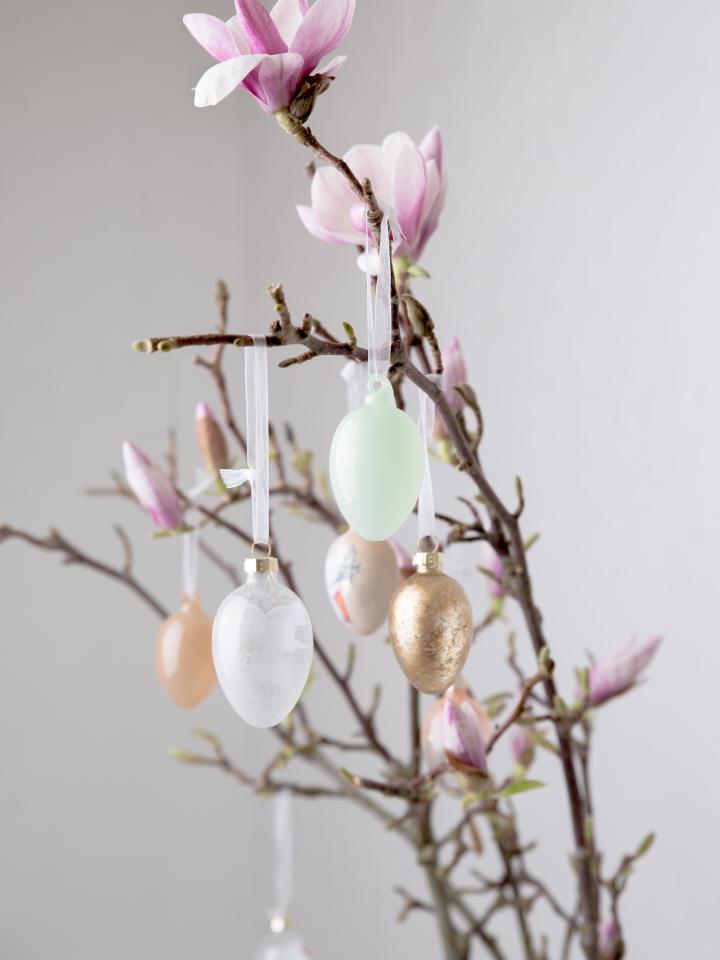
a magnolia easter tree
Magnolia, with its regal blossoms, is a stylish option for a mood-enhancing Easter tree. When the branch blossoms, magnolia treats you to pink or white, tulip-like flowers. The blooms are sweetly scented and the branches are relatively easy to find, usually available from January until early summer.
how to care for your vase of magnolia branches
If you put magnolia branches with closed buds in your vase, it's important not to cut the branches at an angle, which makes them dry out too fast for the blossoms to open. Put the magnolia branches in lukewarm water to encourage flowering.

a pussy willow easter tree
Soft and fluffy pussy willow, with its grey buds, adds a cool and rustic look to your home. Recognisable for their soft, siler-white dots on the branches, pussy willows are a popular choice for an Easter tree. They come into bloom around February or March and can be widely found.
how to care for your vase of pussy willow branches
To keep your pussy willow beautiful for as long as possible, you don't even need to water them in their vase. They can stand dry in the vase and remain stunning while slowly drying out. However, it is important to place the pussy willow away from direct sunlight or other sources of heat. If you let them slowly dry out properly, they can stay beautiful for months.

a birch easter tree
Birch branches are popular for their simple yet elegant look. They give you an airy and light spring feeling, which is enhanced by the fresh green leaves growing on the branches. Birch branches are available all year round, but they start to sprout in spring, making them especially suitable for decorative use.
how to care for your vase of birch branches
To keep birch branches looking lovely in your vase beautiful for as long as possible, cut the branches diagonally and put them in a vase with 5-10 centimetres of cold water.
a flowering quince easter tree
Flowering quince, or chaenomeles, is a blooming beauty. With its pink, orange or red flowers, it provides a bright splash of colour to any room. Turn them into an Easter tree and you'll have a party in your vase! Flowering quince (also sometimes called Japanese quince) is usually available from early spring to summer.
how to care for your vase of flowering quince branches
To enjoy your flowering quince in a vase for as long as possible, cut the branches at an angle and put them in a vase with about 5-10 centimetres of lukewarm water. Do not water them more than necessary, as this may cause the flowers to wilt faster.

a curly willow easter tree
The curly willow is an Easter favourite, and for good reason. The twisting branches and fresh green leaves give willow branches a cheerful, natural look. Willow branches are available all year round, but they especially shine in early spring, looking their brightest at this time of year.
how to care for your vase of curly willow branches
Cut the willow branches diagonally and put them in a vase with about 5-10 centimetres of cold water. Willow branches drink quite a lot, so check regularly if there is enough water in the vase.
how to decorate an easter tree
After you've secured your branches, it's time to decorate! What you choose depends entirely on your personal taste and style. For a luxurious look, choose glass decoration, such as glass Easter eggs or other glass Easter shapes. For an extra-luxurious touch, hang them with velvet ribbons.
If you have young children or prefer to keep it playful and colourful, choose wooden, paper or felt pendants in different, bright colours. You can even make them yourself and turn it into a crafting project!
Are you (or your children) more interested in Easter treats? Perfectly understandable. Decorate your tree with hanging chocolates, eggs, rabbits and other Easter delights.
how to make your easter tree last as long as possible
Having gone to the effort of sourcing and decorating branches for Easter, you want them to last for as long as possible! Check out our tips below for caring for Easter branches:
- Always use a clean vase. Wash the vase thoroughly and remove any remnants of flowers or leaves.
- Cut the branches (except those of magnolia and pussy willow, as mentioned above) diagonally with a sharp knife before putting them in the vase, so that they can absorb the water properly.
- Change the vase water of Easter branches every few days to prevent bacterial growth and to keep the branches fresh for as long as possible.
- Pay attention to the location of your vase: do not put the Easter branches in a draught, in a place with direct sunlight or next to a fruit bowl.
- Remove any leaves and flowers that come into contact with the water or have fallen into the water.
how to cut branches for your easter tree
The branches mentioned above are readily available at your local florist or garden centre. But if you're feeling it, it's simple to source your own branches - especially if you live in a part of the country blessed with plenty of spring growth. Check out our pruning tips:
- Use sharp, clean pruning shears to cut off branches
- Select healthy, strong branches to cut.
- Only cut branches which are already budding, if you're hoping for your Easter tree to flower. If the buds aren't yet developed enough, they will not bloom in your vase.
- Cut the branches to your desired length, making the incision just above a bud.
MORE EASTER INSPIRATION
Discover our Easter dossier full of inspiration or check out our seasonal DIYs, such a delicious floral bread for your Easter table or chewy chocolate cookies made with leftover Easter eggs. Share your Easter creations with us on Facebook and Instagram with the hashtag #thejoyofplants.



